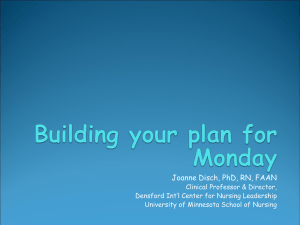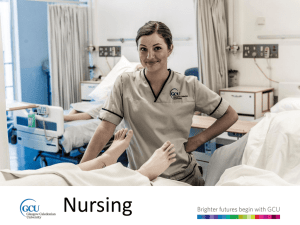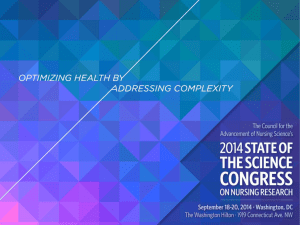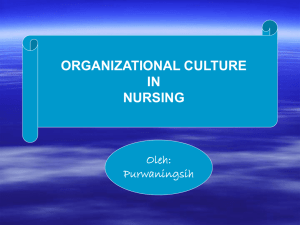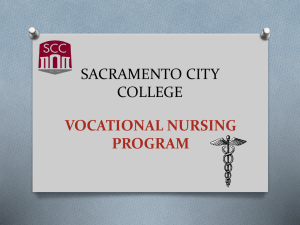Nursing
advertisement
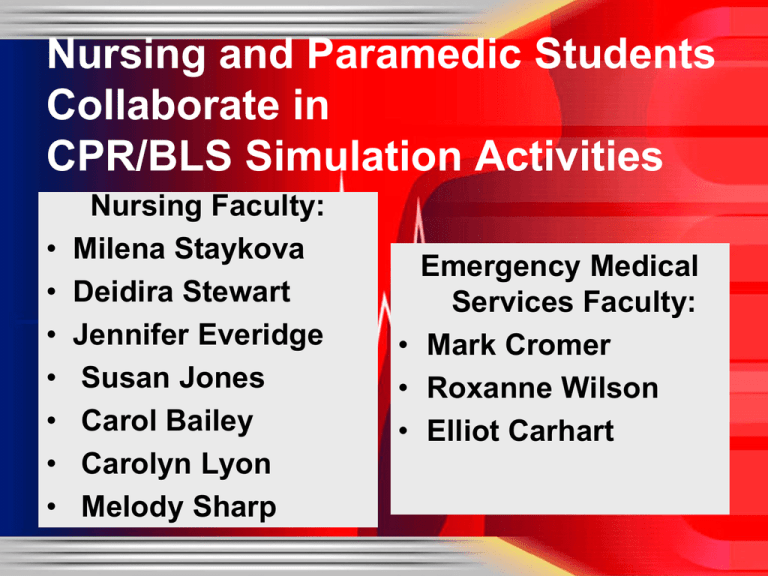
Nursing and Paramedic Students Collaborate in CPR/BLS Simulation Activities • • • • • • • Nursing Faculty: Milena Staykova Deidira Stewart Jennifer Everidge Susan Jones Carol Bailey Carolyn Lyon Melody Sharp Emergency Medical Services Faculty: • Mark Cromer • Roxanne Wilson • Elliot Carhart Objectives Upon completion of the presentation, participants will be able to: • Conclude that CPR/BLS collaborative learning activity increased students’ self-perception of knowledge retention and ability to perform CPR/BLS. • Validate the importance of a collaborative learning activity to improve students’ self-perception of CPR/BLS knowledge retention and skills. • Network with colleagues experienced in nursing and paramedic education and engaging students in active learning. Background • The Institute of Medicine (2003) and the Quality and Safety Education for Nurses (2011) have considered interdisciplinary teamwork and collaboration for improving quality and safety in patient care. • Collaboration between nurses and paramedic personnel is critical for quality of care and for positive patient outcomes in emergency situations (Melby, 2001). • Nursing and paramedic students are expected to demonstrate competence during events requiring CPR/BLS in community or clinical settings. • Studies show that after initial certification, the retention of the CPR/BLS skills requires reinforcement; otherwise, a deterioration of skills is observed (Brown et al., 2006). • In settings of stressful situations nurses, physicians, and paramedics have deviated from the CPR/BLS standards (Martin, 2005). • Many authors urge the curricula of healthcare professionals to reinforce CPR/BLS skills and to evaluate the performance of these skills (Krahan, 2011). Purpose • To encourage the students to practice CPR/BLS skills in a collaborative environment • To help students self-evaluate the retention of CPR/BLS knowledge and skills • To enhance the students’ readiness to enter the multidisciplinary-healthcare field Research question (RQ) and Hypothesis (H): • RQ: For nursing and paramedic students, what is the students’ self-perception of the effects of an interprofessional learning activity on students’ knowledge retention and ability to perform CPR/BLS? • H1: The nursing and paramedic students’ self-perception of knowledge retention and ability to perform CPR/BLS will increase after an interprofessional learning activity. • Hₒ: The nursing and paramedic students’ self-perception of knowledge retention and ability to perform CPR/BLS will NOT increase after an interprofessional learning activity. Method • This IRB approved descriptive study was based on a triangulation (a) IP learning activity based on students’ team interactions (b) 1:1 observation by certified faculty (c) pre-and-post learning-activity survey • Descriptive (%, µ, δ) and Inferential statistics (paired t-test) Sample • A convenience sample of 56 students: - 36 junior-level nursing students - 20 sophomore-level paramedic (EMS) students • 10 Faculty Members: - 8 from nursing program - 3 from paramedic (EMS) program • 1 MSN student Design • A pre-activity survey (white paper) • A 10-item questionnaire (Josipovic, 2009) • A Visual Analog Self-Knowledge Assessment Tool (VASKAT) to collect data: – Zero (0) on the scale- lowest rating – Ten (10) on the scale- highest self-knowledge and skills rating • Case-based simulation activity- 2011 American Heart Association BLS guidelines • Manikins of moderate fidelity • A team of 2 nursing and 1 paramedic students • Collaboration and peer-teaching using professional language and constructive feedback • Post-activity survey- yellow paper EMS and Nursing students’ pre-and-post VASKAT survey percentage agreement on each question Nursing VASKAT EMS VASKAT 100% 10 90% 9.9 60.00% 9.4 9.2 80% 9.8 70% 9.7 60% 9.6 50% 9.5 40% 9.4 9 8.8 40.00% 8.6 Values Values 50.00% Pre-Survey % Post-Survey % 30.00% Mean 8.4 8.2 20.00% 30% 9.3 20% 9.2 8 7.8 10.00% 10% 7.6 9.1 0% 9 1 2 3 4 5 6 Questions 7 8 9 10 0.00% 7.4 1 2 3 4 5 6 Questions 7 8 9 10 Pre-Survey Post Survey Mean Results: Difference in means between the EMS and nursing students’ responses for each question using the VASKAT Camparison of the means 10 9 8 7 6 VASKAT 5 4 3 2 1 0 1 2 3 4 5 6 7 8 9 Questions EMS Pre-Survey EMS Post-Survey Nursing Pre-Survey Nursing Post-Survey 10 Paired t-Test Calculations Df T-Test p-value EMS, n=20 19 2.31154E-08 <0.01 Nursing, n=36 35 1.25876E-44 <0.01 Rejection of the null hypothesis based on the statistical calculation Conclusions • The nursing and paramedic students’ self-perception of knowledge retention and ability to perform CPR/BLS increased after the interprofessional learning activity. • IP activity led to an increase of the students’ selfperception of knowledge retention and ability to perform CPR/BLS after the collaborative activity. • The IP activity was more beneficial to the nursing students. • However, both groups experienced an increased selfperception of knowledge retention and ability to perform CPR/BLS after simulation learning activities. • Nursing students may benefit from curriculum integrating CPR/BLS knowledge and skill refreshment classes or annual CPR/ BLS competency validation. References Josipovic, P., Webb, M., & Mc Grath, I. (2009). Basic life support knowledge of undergraduate nursing and chiropractic students. Australian Journal of Advanced Nursing, 26(4), 58-63. Krahn, R. E. (2011). Basic Life Support: A Call for Reevaluation by Nurse Educators. Nursing Education Perspectives, 32(2), 128. doi:10.5480/1536-5026-32.2.128 Institute of Medicine. (2003, April 18). Health professions education: A bridge to quality [Workshop Report]. Washington, DC: Author. Martin, V. R. (2005). Poor technique: All too common. Nursing, 35(4), 35. Melby, V. (2001). The adrenaline rush: nursing students' experiences with the Northern Ireland Ambulance Service. Journal of Advanced Nursing, 34(6), 727736. Oermann, M. H., Kardong-Edgren, S., Odom-Maryon, T., Ha, Y., McColgan, J. K., Hurd, D., et al. (2010). HeartCodeTM BLS with voice assisted manikin for teaching nursing students: Preliminary results. Nursing Education Perspectives, 31(5), 303308. Söderholm, H. M., & Sonnenwald, D. H. (2010). Visioning future emergency healthcare collaboration: Perspectives from large and small medical centers. Journal of The American Society For Information Science & Technology, 61(9), 1808-1823. Quality and Safety Education for Nurses. (2011). Quality and safety competencies. Chapel Hill, NC: Author. Questions and Comments

